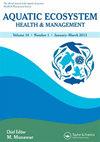利用合作资金实施美国明尼苏达州圣路易斯河关注地区补救行动计划
IF 0.8
4区 环境科学与生态学
Q4 ENVIRONMENTAL SCIENCES
引用次数: 2
摘要
在19世纪末和20世纪初,美国一些主要大亨的合作资助促成了德卢斯、明尼苏达州及其周边地区的发展。其中包括Andrew Carnegie、Jay Cooke、Andrew Mellon、J.P.Morgan和John D.Rockefeller等。这一巨大的增长和扩张时期包括主要的工业发展,包括粮食、木材、铁矿、制造业、铁路、航运和造船,以及边境的相关发展。尽管这些活动对重要社区的发展至关重要,但由于自然栖息地的不受控制的改变和圣路易斯河河口沉积物的污染,这些活动造成了损失。这些不利的遗留影响早在我们目前的环境监管框架建立之前就发生了,1985年,当国际联合委员会的大湖区水质委员会将圣路易斯河确定为一个需要制定和实施补救行动计划以恢复所有受损的有益用途时,这些影响得到了充分的认识。这一对补救行动计划的承诺随后被编入1987年《美加大湖区水质协定议定书》。圣路易斯河关注区第一阶段初步补救行动计划于1992年完成,第二阶段初步补救措施计划于1995年完成,随后定期更新至2012年。然而,这些更新没有必要的预算和行动时间表来确保为执行已确定的行动作出财政承诺。2010年大湖区恢复倡议的制定导致了2013年《补救行动计划》的更新(即第二阶段补救行动计划),其中包括一项确定具体行动、时间表和预算估计的商业计划。明尼苏达州开始通过伙伴关系方式利用合作资金实施建议。补救行动计划中确定的99%的行动已经完成或正在进行中。资金需求和来源已经明确,该项目有望在2020年前完成重大行动,并在2025年前消除所有有益用途减值,并将其列为关注领域,具体取决于用途恢复的确认。本文章由计算机程序翻译,如有差异,请以英文原文为准。
Use of collaborative funding to implement the Remedial Action Plan for the St. Louis River Area of Concern, Minnesota, USA
In the late 1800s and early 1900s, collaborative funding by some of the nation’s leading tycoons led to development of Duluth, Minnesota and the surrounding area. This included Andrew Carnegie, Jay Cooke, Andrew Mellon, J. P. Morgan and John D. Rockefeller, to name a few. This tremendous period of growth and expansion included major industrial developments, including grain, lumber, iron mining, manufacturing, rail, shipping and shipbuilding, and associated development of the frontier. Although critical to the development of a vital community, these activities took a toll through unchecked alteration of natural habitat and contamination of St. Louis River estuary sediments. These adverse legacy impacts, which occurred well before the establishment of our current environmental regulatory framework, became well recognized in 1985 when the International Joint Commission’s Great Lakes Water Quality Board identified the St. Louis River as an Area of Concern requiring the development and implementation of a remedial action plan to restore all impaired beneficial uses. This commitment to Remedial Action Plans was then codified in the 1987 Protocol to the U.S.-Canada Great Lakes Water Quality Agreement. The initial Stage 1 Remedial Action Plans for the St Louis River Area of Concern was completed in 1992 with the initial Stage 2 Remedial Action Plan completed in 1995, followed by periodic updates through 2012. However, these updates did not have budgets and action timelines necessary to secure the financial commitments to implement identified actions. Establishment of the Great Lakes Restoration Initiative in 2010 led to the 2013 Remedial Action Plan update (i.e. Stage 2 Remedial Action Plan) that included a business plan that identified specific actions, timelines, and budget estimates. Minnesota began implementing recommendations utilizing collaborative funding through a partnership approach. Ninety-nine percent of the actions identified in the Remedial Action Plan have been completed or are currently underway. Funding needs and sources have been clearly identified and the project is on track to complete major actions by 2020 and remove all beneficial use impairments and delist as an Area of Concern, dependent upon confirmation of use restoration, by 2025.
求助全文
通过发布文献求助,成功后即可免费获取论文全文。
去求助
来源期刊

Aquatic Ecosystem Health & Management
环境科学-海洋与淡水生物学
CiteScore
1.70
自引率
0.00%
发文量
1
审稿时长
18-36 weeks
期刊介绍:
The journal publishes articles on the following themes and topics:
• Original articles focusing on ecosystem-based sciences, ecosystem health and management of marine and aquatic ecosystems
• Reviews, invited perspectives and keynote contributions from conferences
• Special issues on important emerging topics, themes, and ecosystems (climate change, invasive species, HABs, risk assessment, models)
 求助内容:
求助内容: 应助结果提醒方式:
应助结果提醒方式:


